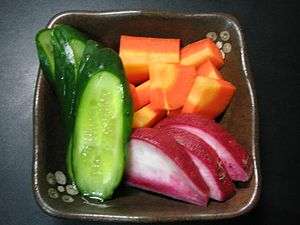Nukazuke
Nukazuke (糠漬け) is a type of Japanese preserved food, made by fermenting vegetables in rice bran (nuka), developed in the 17th century.[1]

Preserved foodstuffs are an important part of Japanese diet. They are often eaten at the end of a meal and are said to aid in digestion. The lactobacillus in nukazuke pickles may be a beneficial supplement to the intestinal flora. Since nukazuke absorb nutrients from the rice bran, they are high in vitamin B1, which helped prevent beri-beri in 17th century Edo (present-day Tokyo).[1]
Almost any edible vegetable may be preserved using this technique. Traditional varieties include eggplant, Japanese radish (daikon), cabbage, and cucumber. The taste of nukazuke can vary from pleasantly tangy to very sour, salty and pungent, depending on the methods and recipe used or region. Usually they have a crispy crunchy texture. Less common are fish nukazuke, found in the north part of Japan, using sardine, mackerel or Japanese horse mackerel.
Wooden Japanese cedar tubes have been traditionally used for the fermentation; nowadays ceramic or plastic containers are also used.
Preparation
Rice bran is first mixed in a crock with salt, kombu seaweed, and water. Some recipes call for ginger, miso, beer or wine. The resultant mash, called nukamiso or nukadoko, has a consistency comparable to wet sand or cooked grits. Vegetables, apple peels, or persimmon peels are added to the nuka-bed every day for at least a few days until a fermenting culture has been established. At this point nuka-bed is ‘live,’ meaning that it contains a culture of active single-celled organisms, mostly lactobacilli and yeast. Although nukazuke can be made from scratch, a bit of well seasoned nuka from an older batch is often used to ‘seed’ a fresh batch.
Unless an established nuka sample is used to seed a fresh batch, the ubiquitous lactic acid-producing colonies crucial to the fermentation process must come from sources such as the skin of the starter vegetables or from human hands.
Once the fermenting cultures have been established the nuka-bed usually develops a complex unique aroma that may be described as anything from "yeasty" to "earthy". At this point the starter vegetables are discarded and pickling vegetables are buried in the bed for as little as a few hours to as long as several months for very strong flavor. Some sources recommend a maximum pickling time of one month. Others suggest that pickles can be left for years in a well-kept nuka-bed. Unpleasant smells such as a "sour" or "stinky" aroma may indicate a problem with the nuka-bed.
Because the process depends on colonies of live organisms, flavors and smells can vary considerably from day to day and the fermenting process slows in colder weather.
When ready, nukazuke pickles are removed from the bed, washed in cool clean water, sliced and served as a side to savory meals.
The nuka-bed must be stirred well daily to keep it from becoming putrescent, moldy or infested with vermin. The acidity, salt content and oxygenation provided by daily stirring keeps toxic microbes from growing in the bed. It is universally recommended that this daily stirring be done with clean bare hands. Depending on the size of the container used, the nuka-bed could be stored temporarily in the fridge for up to two weeks, when daily stirring is not possible.
Sometimes weights made of metal, stone or jugs of water are used the keep the nuka-bed under pressure, drawing water from the vegetables and speeding fermentation.
Nuka-beds are known to acquire subtle flavors from the surrounding environment and thus should not be stored in musty areas.
Additional amounts of rice bran and salt are added from time to time, and some recommend discarding portions of the old nuka to make way for the new. Water is usually provided by the vegetables buried in the bed. With proper maintenance nuka-beds can be kept indefinitely and are often passed down from generation to generation. Old nuka-beds are valued for their nuanced flavor.
Takuan (pickled daikon) is also one variation of nukazuke.Traditional takuan uses sun-dried daikon, however, mass production takuan are often prepared with sugar to cut pickling time.
Ginger, beer, orange seeds, persimmon peels or apple peels can be added to the nuka-bed for flavor.
Dried chili-peppers and/or fresh garlic are often added either for flavor, to keep the bed from becoming wormy, or to keep fermentation in check.
When rice bran cannot be found, alternatives such as wheat bran or even cornflakes have been reported to work well.
See also
- Takuan – A pickled preparation of daikon radish
- Pickled radish – A radish dish served with Korean fried chicken
References
- Katz, Sandor Ellix. Wild fermentation, Chelsea Green, 2003. ISBN 1-931498-23-7
- Tsuji, Shizuo. Japanese cooking: a simple art, Kodansha International, 1980. ISBN 0-87011-399-2
External links
- How to Make Nukazuke: Nukadoko Pickling Bed, February 15, 2009 by Kyoto Foodie
- Nukazuke: Japanese Rice Bran Pickles, April 24, 2009, Wandering Spoon
- https://web.archive.org/web/20031128033242/http://ytoshi.cool.ne.jp/best_friends32/study/cl/food/pickles/pickles1.htm
- http://www.theblackmoon.com/Jfood/ftsuke.html
- http://joi.ito.com/archives/1999/04/04/nukamiso_guide_version_14.html
- http://joi.ito.com/archives/2005/06/20/nukamiso_redux.html